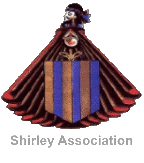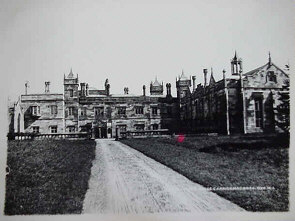

 |
 Shirleys of Lough Fea, Ireland Shirleys of Lough Fea, IrelandLords of the Ettington, Warwickshire |
||||
| < Back to the Robert Shirley, 1st Earl Ferrers | |||||
|
History of Lough Fea Carrickmacross in Co. Monaghan came into existence as a plantation town. It belonged to an area called the Barony of Farney. The Barony of Farney was given by Queen Elizabeth I of England to the First Earl of Essex, Walter Deveraux in 1576. He planned to ‘plant’ the area with settlers and build a walled town around a nearby area called Donaghmoyne. He died, however, in September 1576 and never achieved this. During the following years Ulster was in a state of rebellion. The 2nd Earl of Essex Robert Deveraux asked Queen Elizabeth if he could crush the rebellion. He achieved little, however, and was seen to have displeased the Queen. In 1601 he lost his head and the estate of Farney was taken from the Deveraux family. Queen Elizabeth died in 1603 and James I took the throne. He returned the estate of Farney to the Deveraux family. The Deveraux family faced the problem of local opposition in the area of Farney. The McMahons were the Gaelic Lords of the area and they posed a possible threat to the Deveraux family’s hold on Farney. The family therefore decided to build a stronghold in the area of Farney. They chose Carrickmacross as the place in which they would build a castle. This castle, known as Essex Castle was completed in 1630. Before the castle was built the town did not exist. When the castle was built a street ran northwards from it and became the main street of the town. A survey of the estate carried out by Thomas Raven around that time reveals that before the building of the castle, there was only one properly constructed house. This was an inn belonging to William Ceasar. Beside it were a few hovels. With the arrival of the settlers, plots of land were distributed and fine houses were built. These houses, together with the castle, shaped the foundation of Carrickmacross Town. Essex castle no longer exists. The site on which it was located was acquired by the order of St Louis nuns who came to Carrickmacross in 1888. They started a girl’s secondary school and also took charge of the girls’ national school. Both remain today. The St Louis nuns also started the famous Carrickmacross lace industry. |
The Deveraux Estate passes to the Shirley family In 1646 Robert Deveraux, a later Earl of Essex died leaving no heir. His estate was then passed on to his two sisters Dorothy and Francis. Lady Dorothy was married to Sir Henry Shirley and they had a son Robert who became co-heir. Francis was married to Sir William Seymour. In 1655 the Barony of Farney appears to have been surveyed. This survey shows the contents of every townland and it divides the land into profitable and waste ground. The survey that the whole estate was made up of 47,734 English acres equal to 29, 468 Irish acres and 36, 965 Scottish acres. The Shirley family were absentee landlords, i.e. they did not live on their estates but occasionally visited. About 1750 the Shirley family erected a house adjoining the town of Carrickmacross. This became the occasional residence of the Shirley family. It was located in an area now known as Ivy Lane. There are modern houses located there today. In 1777 the Hon. George Shirley made preparations to erect a castle on the high grounds of an area called the Lurgans. The design of this castle was abandoned and it was not until 1826 that the Hon. George Shirley’s grandson, Evelyn John Shirley Esq. laid the foundation of a mansion worthy of the estate near Lough Fea. This house still remains today. The house is erected entirely of free stone found on the estate and built in the manner of a college. The ground floor holds a Great Hall, a chapel and in the centre are the principal living rooms. At the end of the 19th century the estate had approximately 25,000 acres but these lands had to be sold due to the Land Acts before the First World War. The estate now has less than 1,000 acres of grass and woodland. After the sale of the land, which had been rented to tenants, large mansions such as Shirley’s House became white elephants with little revenue coming in. In 1904 when the present Major Shirley’s grandfather died his father moved from his Ettington Park home in England to Carrickmacross. Between 1904 – 1977 Major Shirley’s father and his family lived there permanently. There was a serious fire at the house in 1966, which did quite a lot of damage. In 1977 the family moved to the Isle of Man and thus reverted to its 19th Century role of absenteeism. But because Major Shirley and his sons were brought up on the estate they have a great love of the place and they do their best to keep the main parts of the building waterproof. Acknowledgements Text taken from: http://www.ulster.ac.uk/thisisland/modules/ Sketch of Essex Castle, Carrickmacross is taken from 'The Monaghan Story', by Peadar Livingstone. County Monaghan - Baronies, taken from 'The Monaghan Story', by Peadar Livingstone. |
||||
 View from the front as you approach the manor house. |
 View from the rear of the manor house |
||||
|
15(xxii). Hon. George Shirley, Lord of Ettington born 23 Oct 1705, lived at Ettington, Warwickshire, England; He died on 22 October 1787 at age 81
|
|||||
|
All Rights Reserved |
|||||